With the announcement of Radiant Melodies, a new soundtrack coming early 2023, it seems like a great time to look at some of the previous Final Fantasy VII soundtracks. Radiant Melodies’ cover was revealed to feature Cloud and Aeris’s church reunion – which certainly illustrates how high Square holds this scene in regard, if it’s meant to represent the entire Final Fantasy VII game’s music.

While Clerith fans cheered, you may not know that this is not without precedent. In fact, Clerith imagery has been used for many of Square’s soundtracks and musical merchandise!
Let’s take a look at a few of them.
Radiant Melodies
Radiant Melodies is being released in commemoration for Final Fantasy VII’s 25th anniversary. Tentatively scheduled for release February 2023, it will feature string and percussion covers of some of the game’s most popular and memorable songs.
As mentioned, the new album cover is Cloud and Aeris’s church reunion – but that’s not all. In Square Enix’s official webpage for the album, a full video of their meeting plays in the background! Check it out here.

Tracks will include:
- Opening – Bombing Mission
- Tifa’s Theme
- Let the Battles Begin!
- Flowers Blooming in the Church
- Fight On!
- Gold Saucer
- Cosmo Canyon
- Descendant of Shinobi
- JENOVA COMPLETE
- One-Winged Angel
Final Fantasy VII Original Soundtrack
It all started with the original Final Fantasy VII soundtrack. This hefty four-disc set was decorated with images of Midgar – and Yoshitaka Amano’s artwork of Cloud and Aeris sitting side-by-side, which can be seen on the front of the booklet.
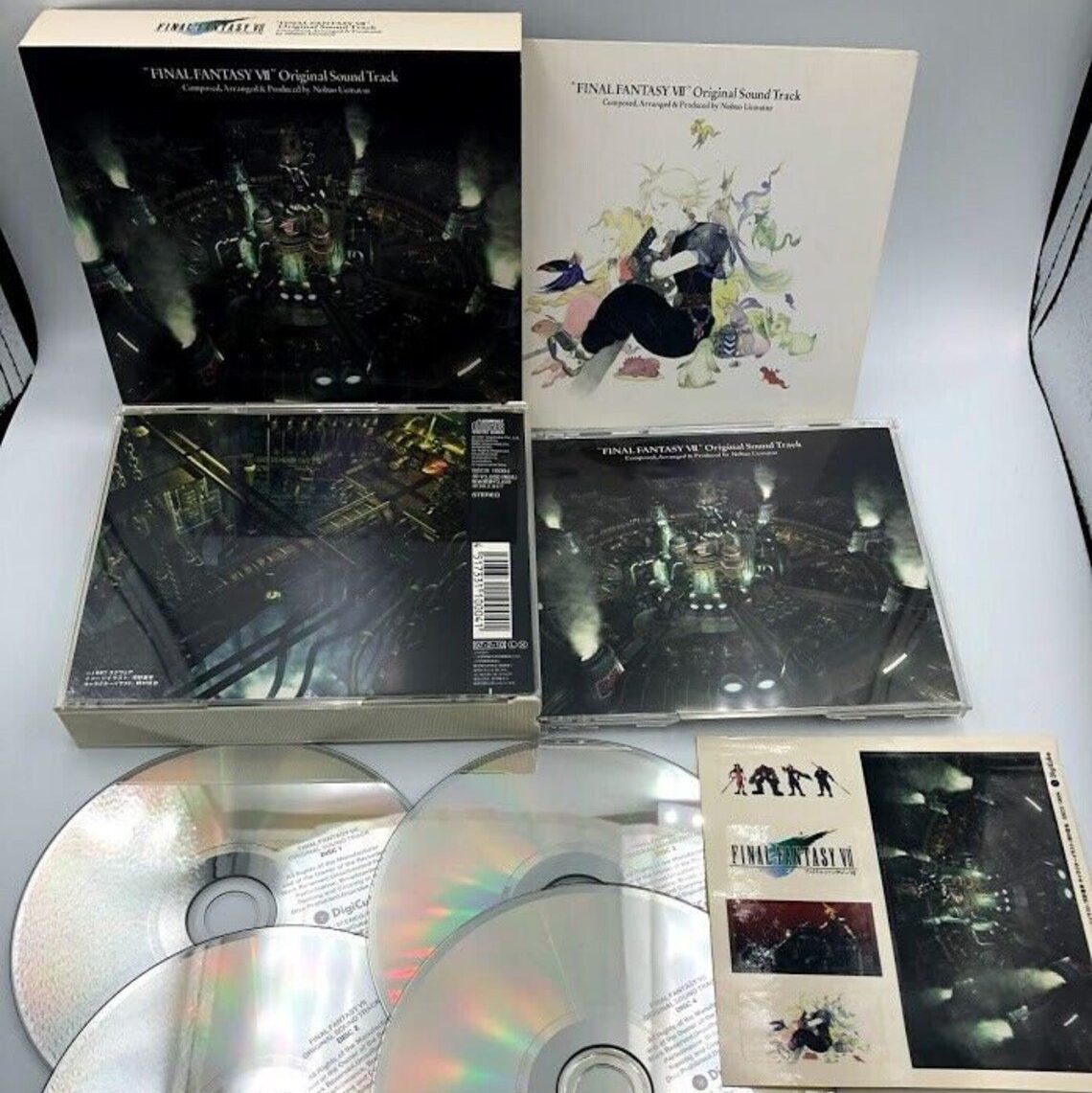
This Amano image here is important: you’ll see it on a number of official Square products, but especially musical soundtracks.
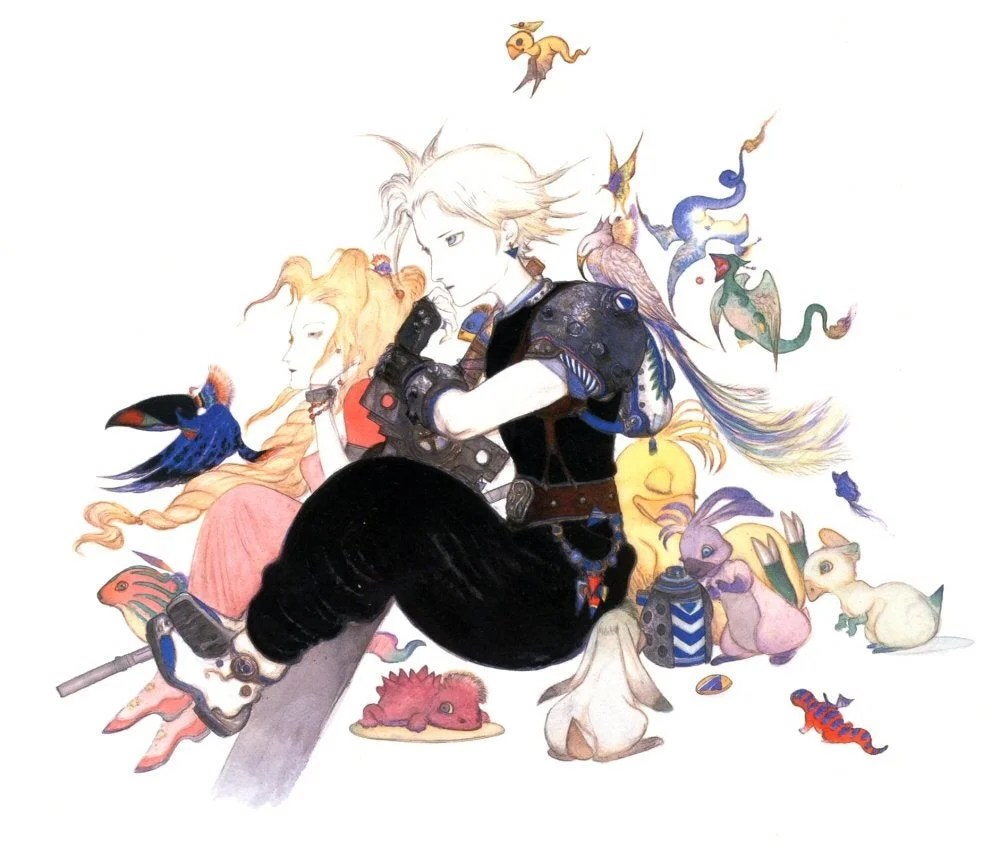
In fact, there exists another variation of the Original Soundtrack: The Japanese edition. This one straight up used this art on the case cover:
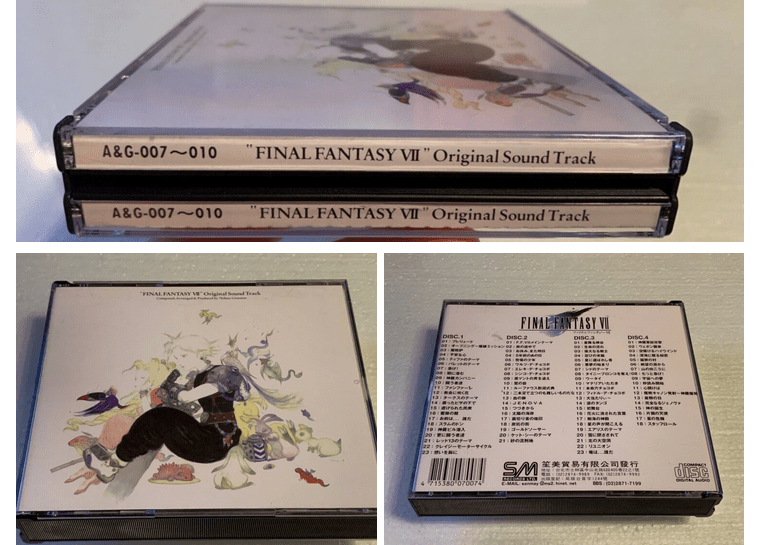
Of course, it’s an aesthetically lovely image – one of the best out of Amano’s Final Fantasy VII art pieces. But the fact that this image of Cloud and Aeris, sitting peacefully side-by-side, is used as cover art to encompass the game’s entire soundtrack is especially meaningful.
Final Fantasy VII Revival Disc
The Revival soundtrack, released in 2019, featured the original music from the game on Blu-Ray – with video footage from the game itself. In Square Enix Shop’s own words:
This set includes a total of 85 tracks from the composer behind some of the FINAL FANTASY series’ most memorable tracks – Nobuo Uematsu – and comes with a booklet which features special commentary from the original development team. We’ve selected the best of the best from this game’s countless memorable scenes and crammed them all into one Blu-ray Disc. Cloud! Aerith! Sephiroth! Bring back all of your best memories.
Square Enix E-Shop (https://store.eu.square-enix-games.com/en_EU/product/560753/final-fantasy-vii-original-soundtrack-revival-disc-blu-ray-disc)
Since the video footage was a special feature of this soundtrack, here’s a really special one!
Go to this soundtrack’s official Japanese website here. What do you see after the intro video? A background video of Cloud and Aeris’s date is one of three possibilities (the other is Cloud and Aeris’s church reunion video, and the third is Sephiroth in Nibelheim.)
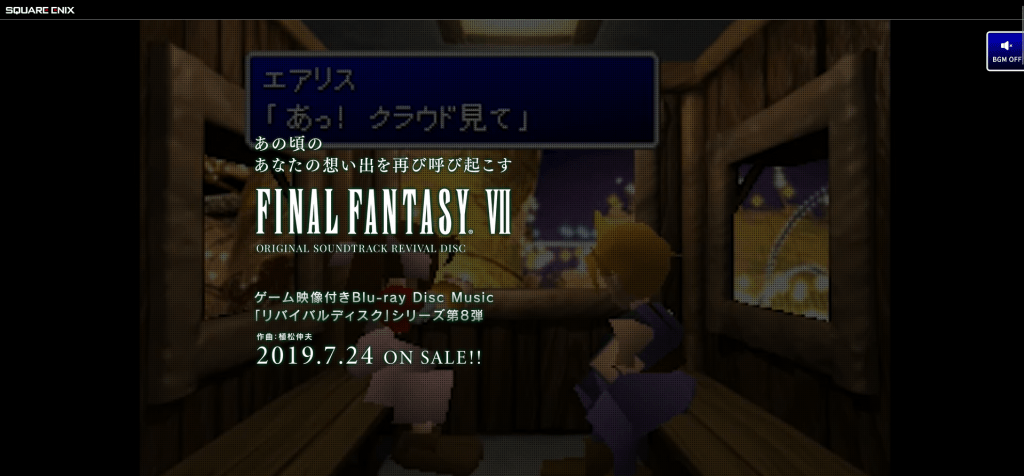
That’s rather extraordinary, as not only is this a romantic scene between Cloud and Aeris, it’s technically optional – which means Square Enix was not bothered that technically, Cloud can date Tifa, Barret, or Yuffie – it canonized Cloud and Aeris’s date and used it as the primary promotional art for the game’s music.
By the way, check out the Revival Discs for Final Fantasy VIII and IX!

Final Fantasy VIII’s site has Squall and Rinoa’s dance as its background, and images of them together otherwise sprinkled throughout the page.
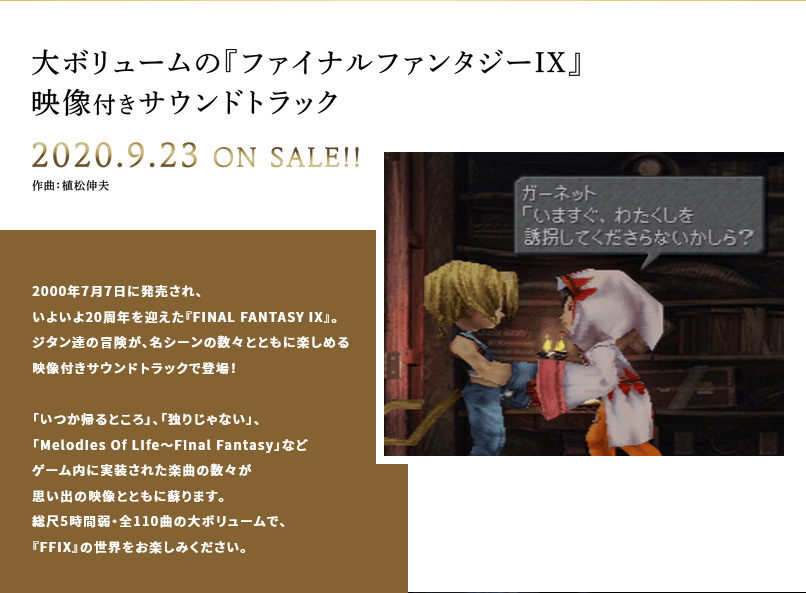
There’s no movie in Final Fantasy IX’s Revival Disc page as of writing this, but at the top – a screenshot of Zidane and Garnet.
Thus, VII, VIII, and IX feature romantic pairings for their Revival discs. VII and VIII both have overtly romantic “date” scenes playing in the background of the page. What a pattern!
Back to VII’s disc: while the cover art is simple, the back of the CD case does feature an image of Cloud and Aeris’s church reunion.

Final Fantasy S Generation Tokyopop CD (2001)
2001 album Final Fantasy S Generation (PlayStation 1 era) Official Best Collection soundtrack featured remixed and orchestrated arrangements of Final Fantasy VII, VIII, and IX musical pieces authorized by Nobuo Uematsu himself. It is licensed by Squaresoft (as is visible in the trademark on the case), who teamed up with Tokyopop for soundtrack distributions prior to the Square Enix merger, at which point they made their own label. The “S” in “S Generation” stands for “Sony” (as in, Sony PlayStation).
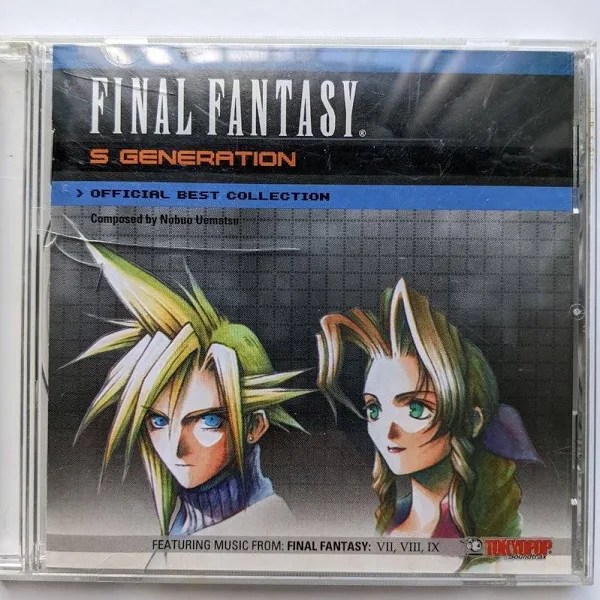
Though it covers the three PlayStation 1 Final Fantasy main titles, who is on the cover? You guessed it: Cloud and Aeris, side-by-side.
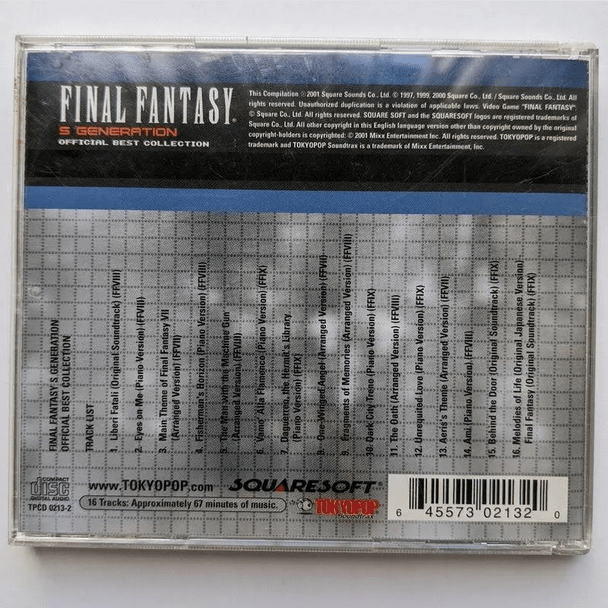

The track list is as follows:
- 1. Liberi Fatali
- 2. Eyes on Me
- 3. Main FF7 Theme
- 4. Fisherman’s Horizon
- 5. The Man With the Machine Gun
- 6. Vamo Alla Flamenco
- 7. Daguerro Hermit’s Library
- 8. One-Winged Angel
- 9. Fragments of Memories
- 10. Dark City Treno
- 11. The Oath
- 12. Unrequited Love
- 13. Aeris’ Theme
- 14. Ami
- 15. Behind the Door
- 16. Melodies of Life
Piano
While not a soundtrack, while we’re on the topic of music, we can’t let the official piano book go unmentioned. Published by DOREMI Music Publishing, this book includes piano sheet music for the full soundtrack. The cover is identical to the original soundtrack cover – an overview of Midgar. And, like the soundtrack, the back features the iconic Amano artwork of Cloud and Aeris.

Not only that, but the inside cover features the same artwork again – blown up even bigger!
Final Fantasy VII Vinyl (Limited Edition)
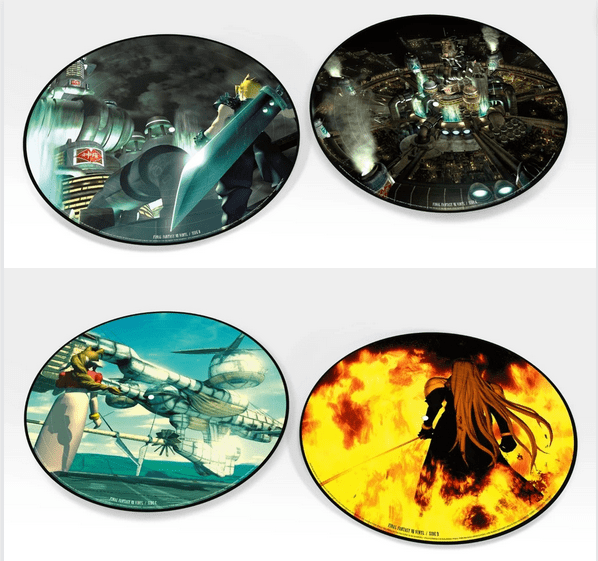
Check out these vinyl discs, which were originally released in 2013 as a limited edition set! They feature the holy trinity of Final Fantasy VII: Cloud, Aeris, and Sephiroth. (This matches certain versions of the original PlayStation game, which also featured these three on the discs.)
Conclusion
When asked what his favorite Final Fantasy VII tracks were, Nobuo Uematsu answered: the Overworld Theme, Cosmo Canyon, and Aerith’s Theme. (source) The Overworld Theme, which acts as Cloud’s own theme, certainly is powerful, and the fact that Uematsu also felt moved by Aerith’s Theme is rather telling. Both themes are featured in virtually every soundtrack, with Aeris’s theme or the variant, Flowers Blooming in the Church. (By the way, read more about how Aeris’s Theme is considered a love song here!)
Using artwork of Cloud and Aeris therefore not only is appropriate, but really demonstrates how important their relationship is in the musical journey of the game.